Epidemiological Analysis: Health Disparities in New Zealand (Maori)
VerifiedAdded on 2020/04/21
|20
|5397
|77
Report
AI Summary
This report examines the health disparities between Maori and non-Maori populations in New Zealand, focusing on differences in morbidity and mortality rates. It highlights the higher prevalence of cardiovascular disease, diabetes, suicide, and other health issues among the Maori population. The report delves into the social and economic factors contributing to these disparities, including income inequality, unemployment, education levels, and housing conditions. It discusses the impact of these factors on health outcomes and explores the need for initiatives to address these disparities. The analysis covers specific statistics on disease prevalence, hospitalization rates, and mortality, illustrating the significant health challenges faced by the Maori community. The report emphasizes the importance of understanding these factors to develop effective strategies for improving Maori health and reducing health inequalities in New Zealand.
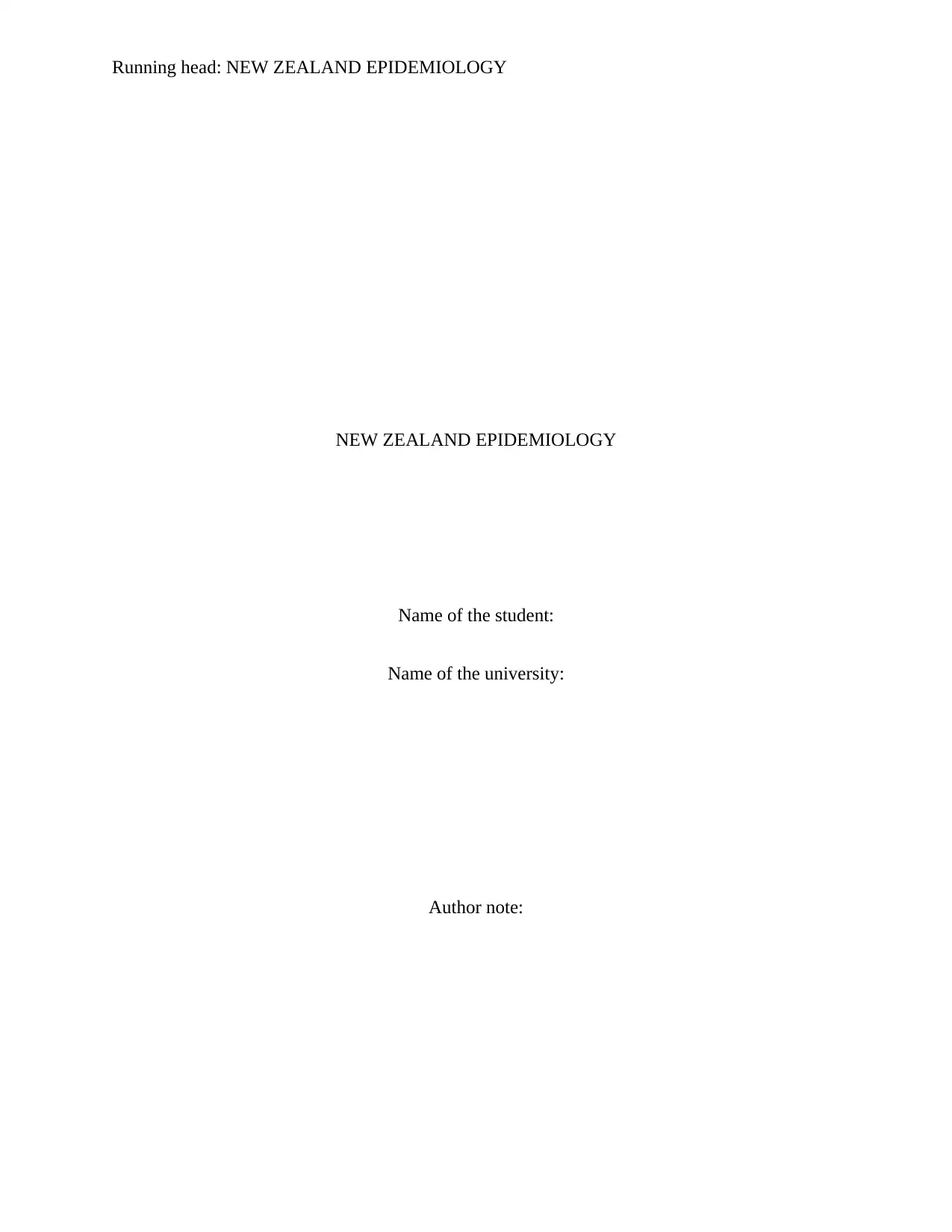
Running head: NEW ZEALAND EPIDEMIOLOGY
NEW ZEALAND EPIDEMIOLOGY
Name of the student:
Name of the university:
Author note:
NEW ZEALAND EPIDEMIOLOGY
Name of the student:
Name of the university:
Author note:
Paraphrase This Document
Need a fresh take? Get an instant paraphrase of this document with our AI Paraphraser
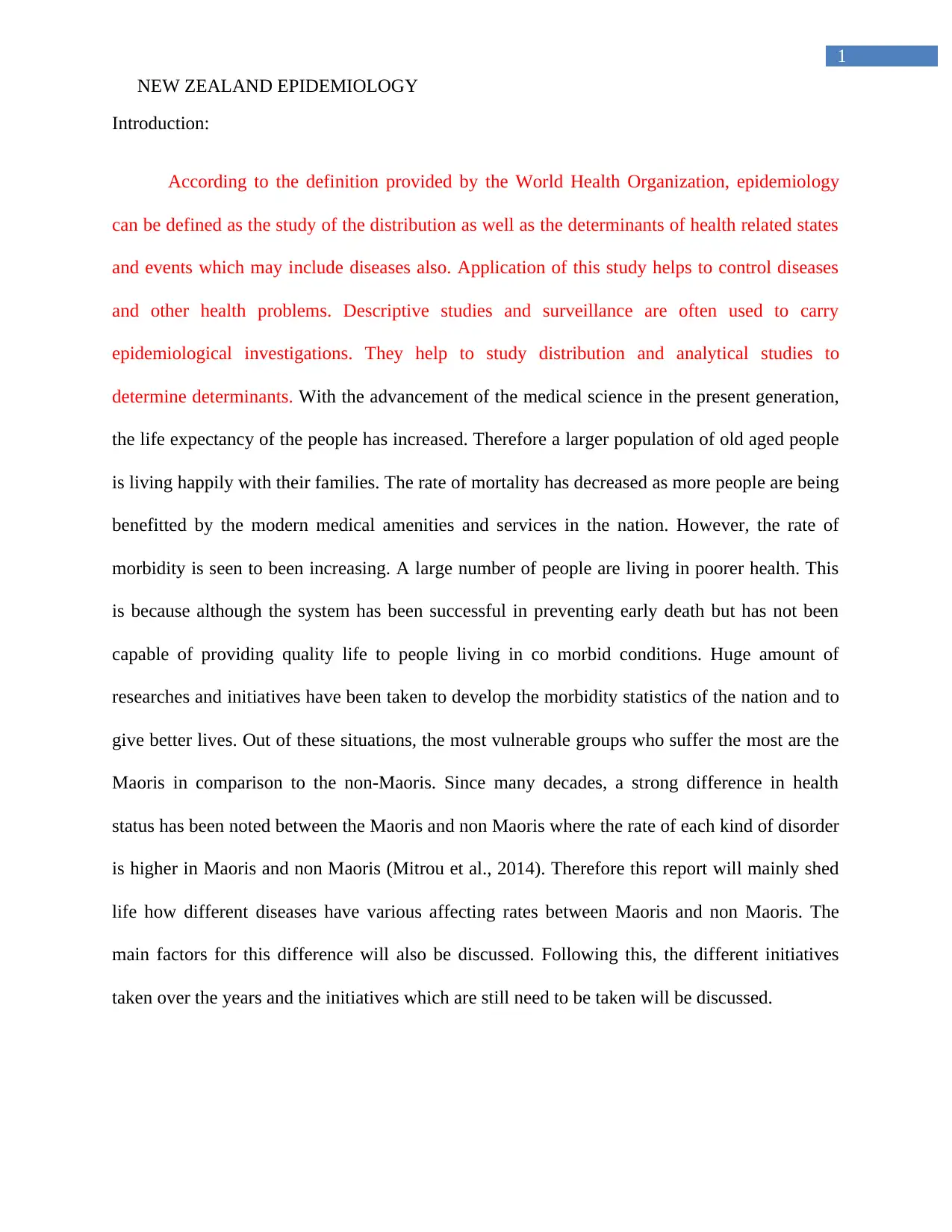
1
NEW ZEALAND EPIDEMIOLOGY
Introduction:
According to the definition provided by the World Health Organization, epidemiology
can be defined as the study of the distribution as well as the determinants of health related states
and events which may include diseases also. Application of this study helps to control diseases
and other health problems. Descriptive studies and surveillance are often used to carry
epidemiological investigations. They help to study distribution and analytical studies to
determine determinants. With the advancement of the medical science in the present generation,
the life expectancy of the people has increased. Therefore a larger population of old aged people
is living happily with their families. The rate of mortality has decreased as more people are being
benefitted by the modern medical amenities and services in the nation. However, the rate of
morbidity is seen to been increasing. A large number of people are living in poorer health. This
is because although the system has been successful in preventing early death but has not been
capable of providing quality life to people living in co morbid conditions. Huge amount of
researches and initiatives have been taken to develop the morbidity statistics of the nation and to
give better lives. Out of these situations, the most vulnerable groups who suffer the most are the
Maoris in comparison to the non-Maoris. Since many decades, a strong difference in health
status has been noted between the Maoris and non Maoris where the rate of each kind of disorder
is higher in Maoris and non Maoris (Mitrou et al., 2014). Therefore this report will mainly shed
life how different diseases have various affecting rates between Maoris and non Maoris. The
main factors for this difference will also be discussed. Following this, the different initiatives
taken over the years and the initiatives which are still need to be taken will be discussed.
NEW ZEALAND EPIDEMIOLOGY
Introduction:
According to the definition provided by the World Health Organization, epidemiology
can be defined as the study of the distribution as well as the determinants of health related states
and events which may include diseases also. Application of this study helps to control diseases
and other health problems. Descriptive studies and surveillance are often used to carry
epidemiological investigations. They help to study distribution and analytical studies to
determine determinants. With the advancement of the medical science in the present generation,
the life expectancy of the people has increased. Therefore a larger population of old aged people
is living happily with their families. The rate of mortality has decreased as more people are being
benefitted by the modern medical amenities and services in the nation. However, the rate of
morbidity is seen to been increasing. A large number of people are living in poorer health. This
is because although the system has been successful in preventing early death but has not been
capable of providing quality life to people living in co morbid conditions. Huge amount of
researches and initiatives have been taken to develop the morbidity statistics of the nation and to
give better lives. Out of these situations, the most vulnerable groups who suffer the most are the
Maoris in comparison to the non-Maoris. Since many decades, a strong difference in health
status has been noted between the Maoris and non Maoris where the rate of each kind of disorder
is higher in Maoris and non Maoris (Mitrou et al., 2014). Therefore this report will mainly shed
life how different diseases have various affecting rates between Maoris and non Maoris. The
main factors for this difference will also be discussed. Following this, the different initiatives
taken over the years and the initiatives which are still need to be taken will be discussed.
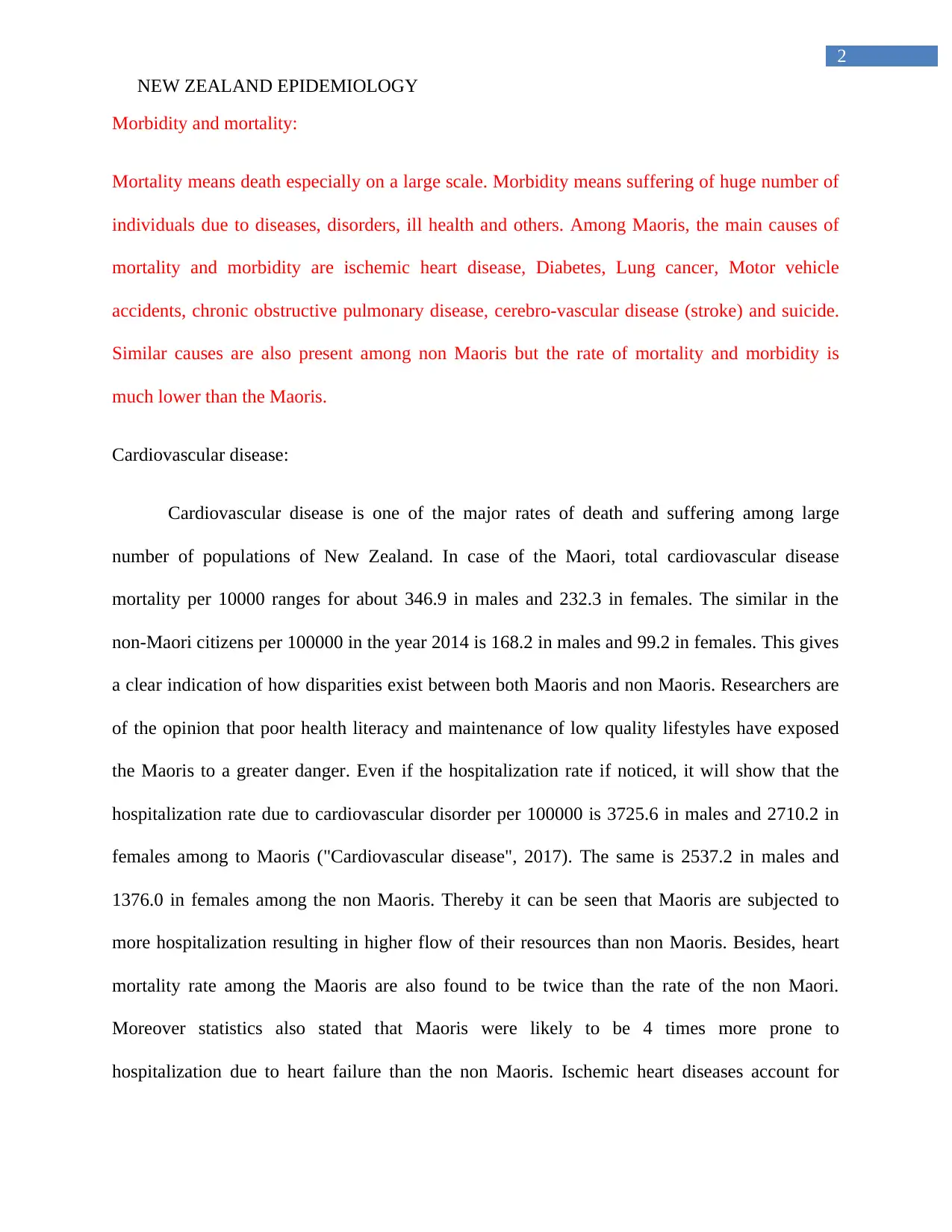
2
NEW ZEALAND EPIDEMIOLOGY
Morbidity and mortality:
Mortality means death especially on a large scale. Morbidity means suffering of huge number of
individuals due to diseases, disorders, ill health and others. Among Maoris, the main causes of
mortality and morbidity are ischemic heart disease, Diabetes, Lung cancer, Motor vehicle
accidents, chronic obstructive pulmonary disease, cerebro-vascular disease (stroke) and suicide.
Similar causes are also present among non Maoris but the rate of mortality and morbidity is
much lower than the Maoris.
Cardiovascular disease:
Cardiovascular disease is one of the major rates of death and suffering among large
number of populations of New Zealand. In case of the Maori, total cardiovascular disease
mortality per 10000 ranges for about 346.9 in males and 232.3 in females. The similar in the
non-Maori citizens per 100000 in the year 2014 is 168.2 in males and 99.2 in females. This gives
a clear indication of how disparities exist between both Maoris and non Maoris. Researchers are
of the opinion that poor health literacy and maintenance of low quality lifestyles have exposed
the Maoris to a greater danger. Even if the hospitalization rate if noticed, it will show that the
hospitalization rate due to cardiovascular disorder per 100000 is 3725.6 in males and 2710.2 in
females among to Maoris ("Cardiovascular disease", 2017). The same is 2537.2 in males and
1376.0 in females among the non Maoris. Thereby it can be seen that Maoris are subjected to
more hospitalization resulting in higher flow of their resources than non Maoris. Besides, heart
mortality rate among the Maoris are also found to be twice than the rate of the non Maori.
Moreover statistics also stated that Maoris were likely to be 4 times more prone to
hospitalization due to heart failure than the non Maoris. Ischemic heart diseases account for
NEW ZEALAND EPIDEMIOLOGY
Morbidity and mortality:
Mortality means death especially on a large scale. Morbidity means suffering of huge number of
individuals due to diseases, disorders, ill health and others. Among Maoris, the main causes of
mortality and morbidity are ischemic heart disease, Diabetes, Lung cancer, Motor vehicle
accidents, chronic obstructive pulmonary disease, cerebro-vascular disease (stroke) and suicide.
Similar causes are also present among non Maoris but the rate of mortality and morbidity is
much lower than the Maoris.
Cardiovascular disease:
Cardiovascular disease is one of the major rates of death and suffering among large
number of populations of New Zealand. In case of the Maori, total cardiovascular disease
mortality per 10000 ranges for about 346.9 in males and 232.3 in females. The similar in the
non-Maori citizens per 100000 in the year 2014 is 168.2 in males and 99.2 in females. This gives
a clear indication of how disparities exist between both Maoris and non Maoris. Researchers are
of the opinion that poor health literacy and maintenance of low quality lifestyles have exposed
the Maoris to a greater danger. Even if the hospitalization rate if noticed, it will show that the
hospitalization rate due to cardiovascular disorder per 100000 is 3725.6 in males and 2710.2 in
females among to Maoris ("Cardiovascular disease", 2017). The same is 2537.2 in males and
1376.0 in females among the non Maoris. Thereby it can be seen that Maoris are subjected to
more hospitalization resulting in higher flow of their resources than non Maoris. Besides, heart
mortality rate among the Maoris are also found to be twice than the rate of the non Maori.
Moreover statistics also stated that Maoris were likely to be 4 times more prone to
hospitalization due to heart failure than the non Maoris. Ischemic heart diseases account for
⊘ This is a preview!⊘
Do you want full access?
Subscribe today to unlock all pages.

Trusted by 1+ million students worldwide
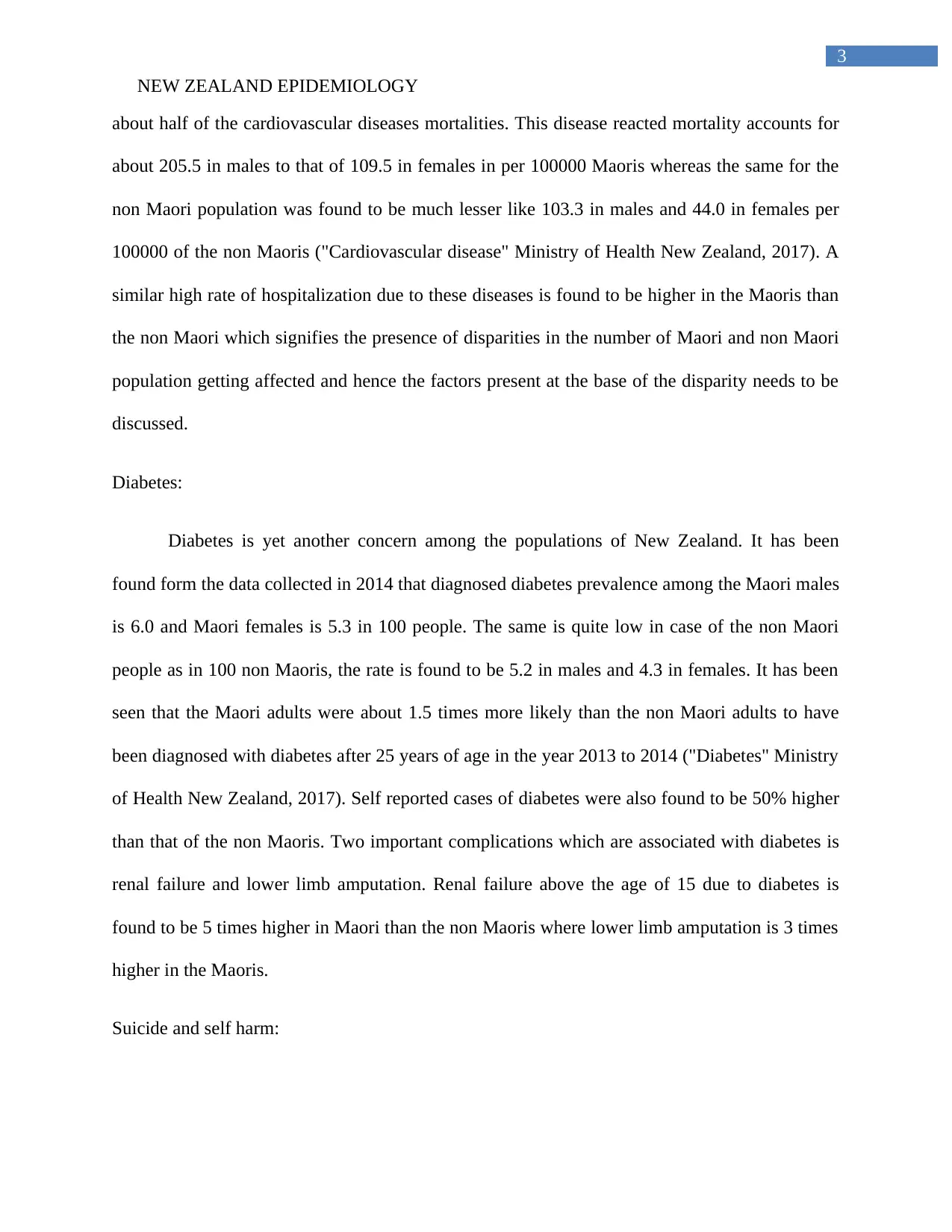
3
NEW ZEALAND EPIDEMIOLOGY
about half of the cardiovascular diseases mortalities. This disease reacted mortality accounts for
about 205.5 in males to that of 109.5 in females in per 100000 Maoris whereas the same for the
non Maori population was found to be much lesser like 103.3 in males and 44.0 in females per
100000 of the non Maoris ("Cardiovascular disease" Ministry of Health New Zealand, 2017). A
similar high rate of hospitalization due to these diseases is found to be higher in the Maoris than
the non Maori which signifies the presence of disparities in the number of Maori and non Maori
population getting affected and hence the factors present at the base of the disparity needs to be
discussed.
Diabetes:
Diabetes is yet another concern among the populations of New Zealand. It has been
found form the data collected in 2014 that diagnosed diabetes prevalence among the Maori males
is 6.0 and Maori females is 5.3 in 100 people. The same is quite low in case of the non Maori
people as in 100 non Maoris, the rate is found to be 5.2 in males and 4.3 in females. It has been
seen that the Maori adults were about 1.5 times more likely than the non Maori adults to have
been diagnosed with diabetes after 25 years of age in the year 2013 to 2014 ("Diabetes" Ministry
of Health New Zealand, 2017). Self reported cases of diabetes were also found to be 50% higher
than that of the non Maoris. Two important complications which are associated with diabetes is
renal failure and lower limb amputation. Renal failure above the age of 15 due to diabetes is
found to be 5 times higher in Maori than the non Maoris where lower limb amputation is 3 times
higher in the Maoris.
Suicide and self harm:
NEW ZEALAND EPIDEMIOLOGY
about half of the cardiovascular diseases mortalities. This disease reacted mortality accounts for
about 205.5 in males to that of 109.5 in females in per 100000 Maoris whereas the same for the
non Maori population was found to be much lesser like 103.3 in males and 44.0 in females per
100000 of the non Maoris ("Cardiovascular disease" Ministry of Health New Zealand, 2017). A
similar high rate of hospitalization due to these diseases is found to be higher in the Maoris than
the non Maori which signifies the presence of disparities in the number of Maori and non Maori
population getting affected and hence the factors present at the base of the disparity needs to be
discussed.
Diabetes:
Diabetes is yet another concern among the populations of New Zealand. It has been
found form the data collected in 2014 that diagnosed diabetes prevalence among the Maori males
is 6.0 and Maori females is 5.3 in 100 people. The same is quite low in case of the non Maori
people as in 100 non Maoris, the rate is found to be 5.2 in males and 4.3 in females. It has been
seen that the Maori adults were about 1.5 times more likely than the non Maori adults to have
been diagnosed with diabetes after 25 years of age in the year 2013 to 2014 ("Diabetes" Ministry
of Health New Zealand, 2017). Self reported cases of diabetes were also found to be 50% higher
than that of the non Maoris. Two important complications which are associated with diabetes is
renal failure and lower limb amputation. Renal failure above the age of 15 due to diabetes is
found to be 5 times higher in Maori than the non Maoris where lower limb amputation is 3 times
higher in the Maoris.
Suicide and self harm:
Paraphrase This Document
Need a fresh take? Get an instant paraphrase of this document with our AI Paraphraser
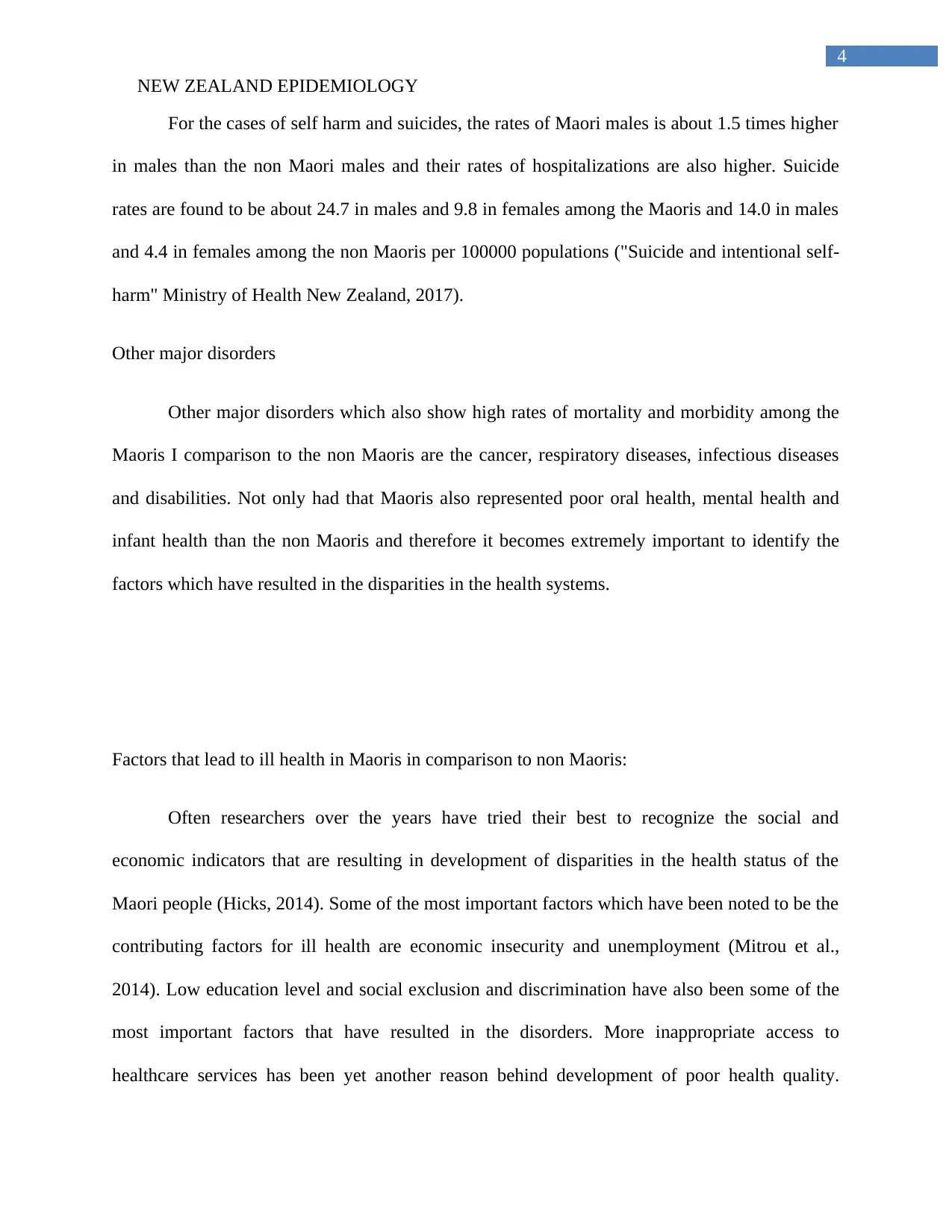
4
NEW ZEALAND EPIDEMIOLOGY
For the cases of self harm and suicides, the rates of Maori males is about 1.5 times higher
in males than the non Maori males and their rates of hospitalizations are also higher. Suicide
rates are found to be about 24.7 in males and 9.8 in females among the Maoris and 14.0 in males
and 4.4 in females among the non Maoris per 100000 populations ("Suicide and intentional self-
harm" Ministry of Health New Zealand, 2017).
Other major disorders
Other major disorders which also show high rates of mortality and morbidity among the
Maoris I comparison to the non Maoris are the cancer, respiratory diseases, infectious diseases
and disabilities. Not only had that Maoris also represented poor oral health, mental health and
infant health than the non Maoris and therefore it becomes extremely important to identify the
factors which have resulted in the disparities in the health systems.
Factors that lead to ill health in Maoris in comparison to non Maoris:
Often researchers over the years have tried their best to recognize the social and
economic indicators that are resulting in development of disparities in the health status of the
Maori people (Hicks, 2014). Some of the most important factors which have been noted to be the
contributing factors for ill health are economic insecurity and unemployment (Mitrou et al.,
2014). Low education level and social exclusion and discrimination have also been some of the
most important factors that have resulted in the disorders. More inappropriate access to
healthcare services has been yet another reason behind development of poor health quality.
NEW ZEALAND EPIDEMIOLOGY
For the cases of self harm and suicides, the rates of Maori males is about 1.5 times higher
in males than the non Maori males and their rates of hospitalizations are also higher. Suicide
rates are found to be about 24.7 in males and 9.8 in females among the Maoris and 14.0 in males
and 4.4 in females among the non Maoris per 100000 populations ("Suicide and intentional self-
harm" Ministry of Health New Zealand, 2017).
Other major disorders
Other major disorders which also show high rates of mortality and morbidity among the
Maoris I comparison to the non Maoris are the cancer, respiratory diseases, infectious diseases
and disabilities. Not only had that Maoris also represented poor oral health, mental health and
infant health than the non Maoris and therefore it becomes extremely important to identify the
factors which have resulted in the disparities in the health systems.
Factors that lead to ill health in Maoris in comparison to non Maoris:
Often researchers over the years have tried their best to recognize the social and
economic indicators that are resulting in development of disparities in the health status of the
Maori people (Hicks, 2014). Some of the most important factors which have been noted to be the
contributing factors for ill health are economic insecurity and unemployment (Mitrou et al.,
2014). Low education level and social exclusion and discrimination have also been some of the
most important factors that have resulted in the disorders. More inappropriate access to
healthcare services has been yet another reason behind development of poor health quality.
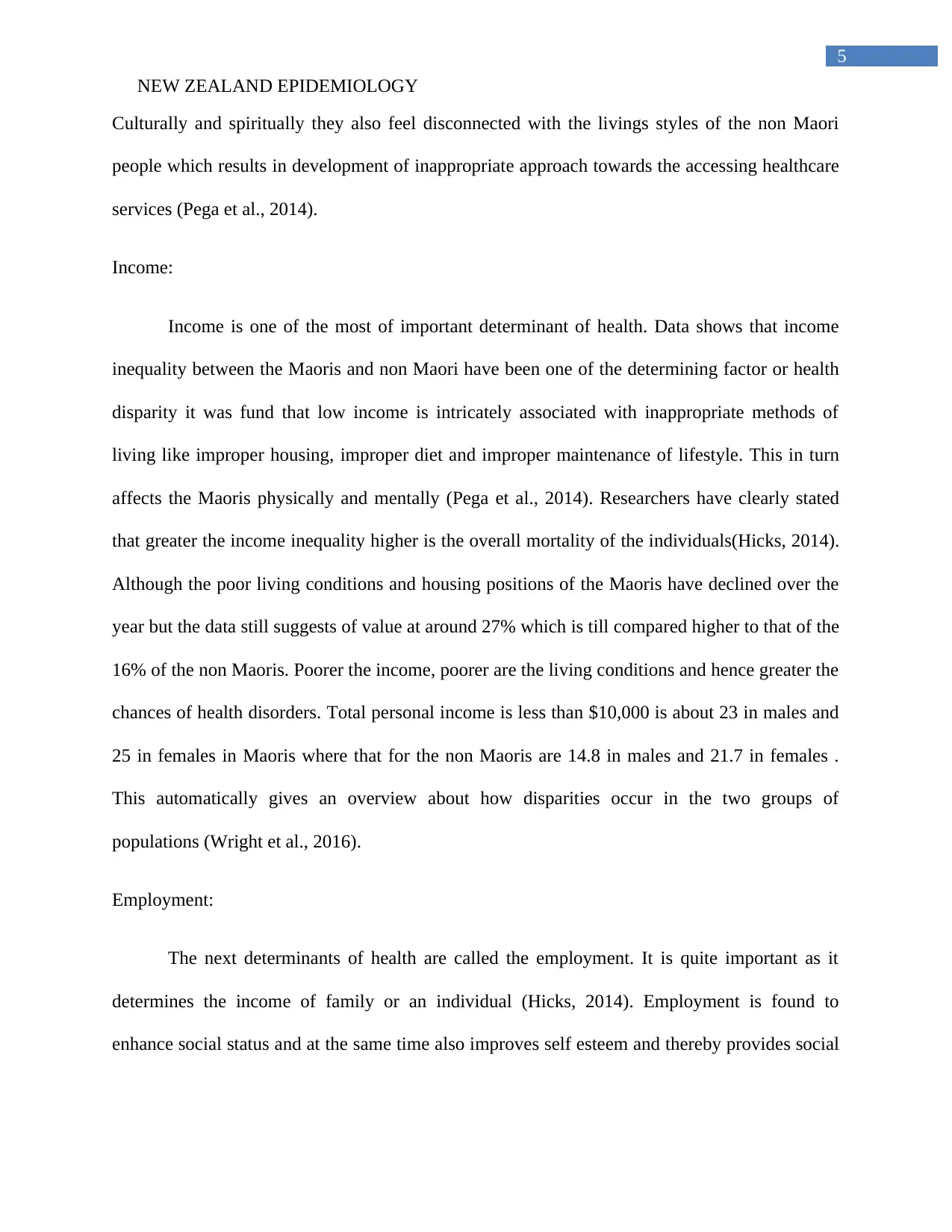
5
NEW ZEALAND EPIDEMIOLOGY
Culturally and spiritually they also feel disconnected with the livings styles of the non Maori
people which results in development of inappropriate approach towards the accessing healthcare
services (Pega et al., 2014).
Income:
Income is one of the most of important determinant of health. Data shows that income
inequality between the Maoris and non Maori have been one of the determining factor or health
disparity it was fund that low income is intricately associated with inappropriate methods of
living like improper housing, improper diet and improper maintenance of lifestyle. This in turn
affects the Maoris physically and mentally (Pega et al., 2014). Researchers have clearly stated
that greater the income inequality higher is the overall mortality of the individuals(Hicks, 2014).
Although the poor living conditions and housing positions of the Maoris have declined over the
year but the data still suggests of value at around 27% which is till compared higher to that of the
16% of the non Maoris. Poorer the income, poorer are the living conditions and hence greater the
chances of health disorders. Total personal income is less than $10,000 is about 23 in males and
25 in females in Maoris where that for the non Maoris are 14.8 in males and 21.7 in females .
This automatically gives an overview about how disparities occur in the two groups of
populations (Wright et al., 2016).
Employment:
The next determinants of health are called the employment. It is quite important as it
determines the income of family or an individual (Hicks, 2014). Employment is found to
enhance social status and at the same time also improves self esteem and thereby provides social
NEW ZEALAND EPIDEMIOLOGY
Culturally and spiritually they also feel disconnected with the livings styles of the non Maori
people which results in development of inappropriate approach towards the accessing healthcare
services (Pega et al., 2014).
Income:
Income is one of the most of important determinant of health. Data shows that income
inequality between the Maoris and non Maori have been one of the determining factor or health
disparity it was fund that low income is intricately associated with inappropriate methods of
living like improper housing, improper diet and improper maintenance of lifestyle. This in turn
affects the Maoris physically and mentally (Pega et al., 2014). Researchers have clearly stated
that greater the income inequality higher is the overall mortality of the individuals(Hicks, 2014).
Although the poor living conditions and housing positions of the Maoris have declined over the
year but the data still suggests of value at around 27% which is till compared higher to that of the
16% of the non Maoris. Poorer the income, poorer are the living conditions and hence greater the
chances of health disorders. Total personal income is less than $10,000 is about 23 in males and
25 in females in Maoris where that for the non Maoris are 14.8 in males and 21.7 in females .
This automatically gives an overview about how disparities occur in the two groups of
populations (Wright et al., 2016).
Employment:
The next determinants of health are called the employment. It is quite important as it
determines the income of family or an individual (Hicks, 2014). Employment is found to
enhance social status and at the same time also improves self esteem and thereby provides social
⊘ This is a preview!⊘
Do you want full access?
Subscribe today to unlock all pages.

Trusted by 1+ million students worldwide
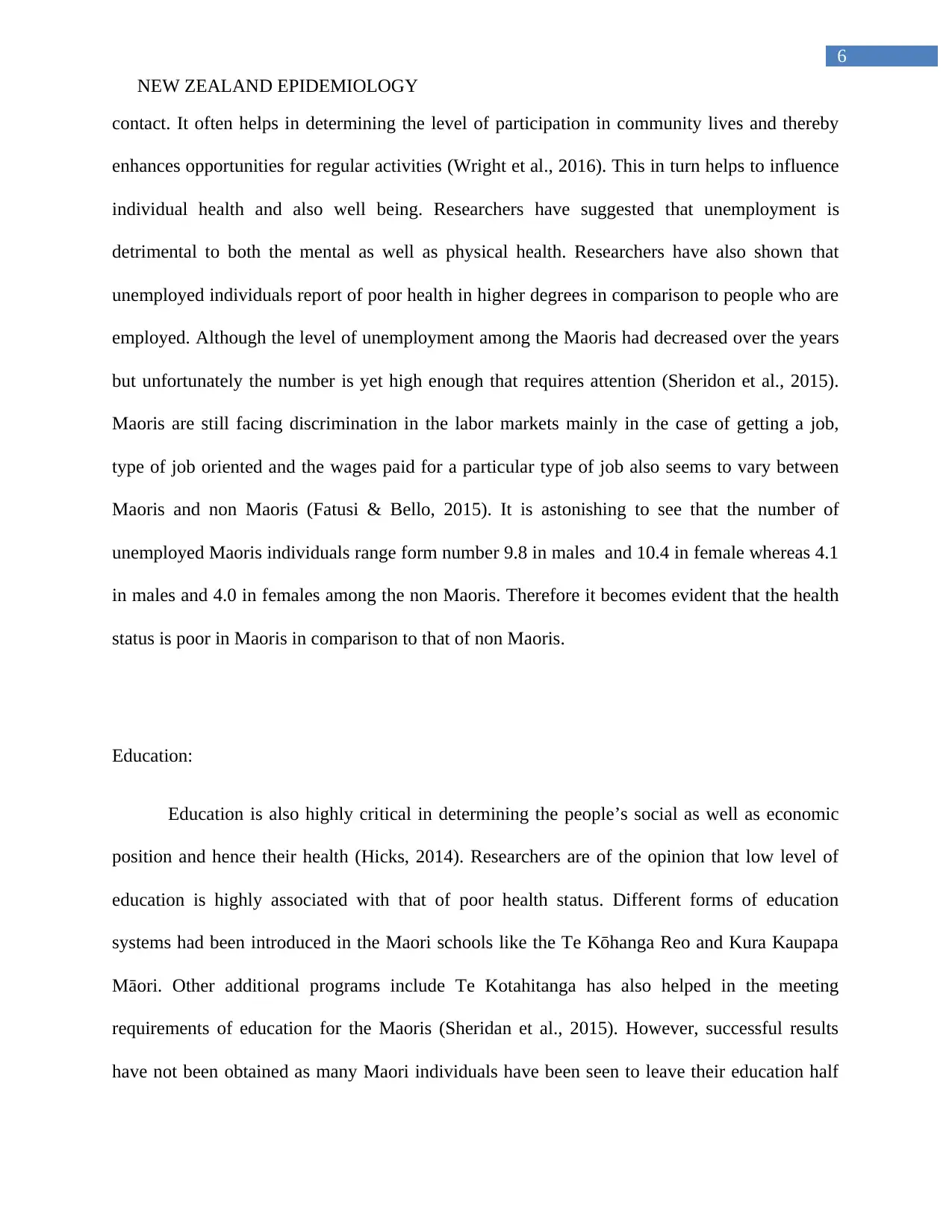
6
NEW ZEALAND EPIDEMIOLOGY
contact. It often helps in determining the level of participation in community lives and thereby
enhances opportunities for regular activities (Wright et al., 2016). This in turn helps to influence
individual health and also well being. Researchers have suggested that unemployment is
detrimental to both the mental as well as physical health. Researchers have also shown that
unemployed individuals report of poor health in higher degrees in comparison to people who are
employed. Although the level of unemployment among the Maoris had decreased over the years
but unfortunately the number is yet high enough that requires attention (Sheridon et al., 2015).
Maoris are still facing discrimination in the labor markets mainly in the case of getting a job,
type of job oriented and the wages paid for a particular type of job also seems to vary between
Maoris and non Maoris (Fatusi & Bello, 2015). It is astonishing to see that the number of
unemployed Maoris individuals range form number 9.8 in males and 10.4 in female whereas 4.1
in males and 4.0 in females among the non Maoris. Therefore it becomes evident that the health
status is poor in Maoris in comparison to that of non Maoris.
Education:
Education is also highly critical in determining the people’s social as well as economic
position and hence their health (Hicks, 2014). Researchers are of the opinion that low level of
education is highly associated with that of poor health status. Different forms of education
systems had been introduced in the Maori schools like the Te Kōhanga Reo and Kura Kaupapa
Māori. Other additional programs include Te Kotahitanga has also helped in the meeting
requirements of education for the Maoris (Sheridan et al., 2015). However, successful results
have not been obtained as many Maori individuals have been seen to leave their education half
NEW ZEALAND EPIDEMIOLOGY
contact. It often helps in determining the level of participation in community lives and thereby
enhances opportunities for regular activities (Wright et al., 2016). This in turn helps to influence
individual health and also well being. Researchers have suggested that unemployment is
detrimental to both the mental as well as physical health. Researchers have also shown that
unemployed individuals report of poor health in higher degrees in comparison to people who are
employed. Although the level of unemployment among the Maoris had decreased over the years
but unfortunately the number is yet high enough that requires attention (Sheridon et al., 2015).
Maoris are still facing discrimination in the labor markets mainly in the case of getting a job,
type of job oriented and the wages paid for a particular type of job also seems to vary between
Maoris and non Maoris (Fatusi & Bello, 2015). It is astonishing to see that the number of
unemployed Maoris individuals range form number 9.8 in males and 10.4 in female whereas 4.1
in males and 4.0 in females among the non Maoris. Therefore it becomes evident that the health
status is poor in Maoris in comparison to that of non Maoris.
Education:
Education is also highly critical in determining the people’s social as well as economic
position and hence their health (Hicks, 2014). Researchers are of the opinion that low level of
education is highly associated with that of poor health status. Different forms of education
systems had been introduced in the Maori schools like the Te Kōhanga Reo and Kura Kaupapa
Māori. Other additional programs include Te Kotahitanga has also helped in the meeting
requirements of education for the Maoris (Sheridan et al., 2015). However, successful results
have not been obtained as many Maori individuals have been seen to leave their education half
Paraphrase This Document
Need a fresh take? Get an instant paraphrase of this document with our AI Paraphraser
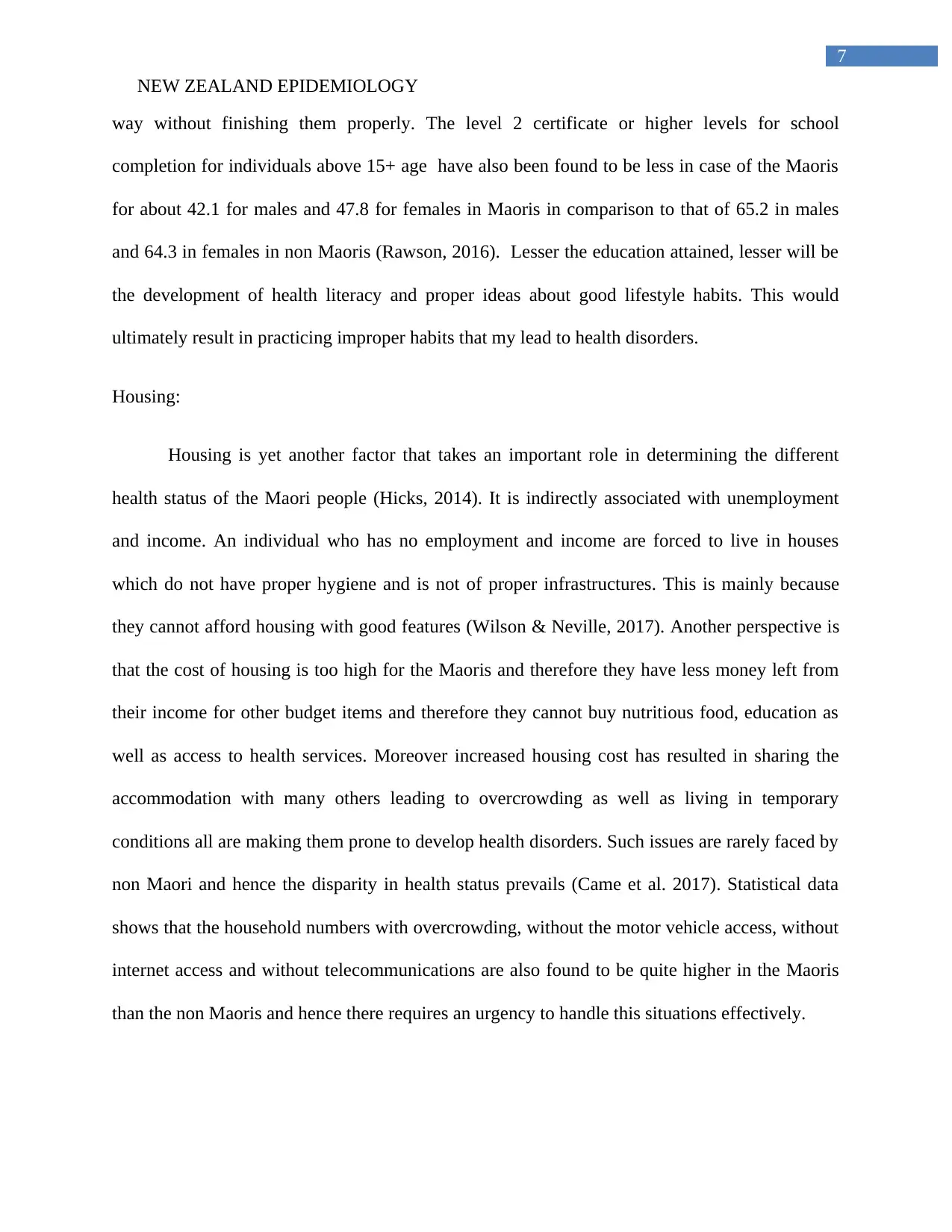
7
NEW ZEALAND EPIDEMIOLOGY
way without finishing them properly. The level 2 certificate or higher levels for school
completion for individuals above 15+ age have also been found to be less in case of the Maoris
for about 42.1 for males and 47.8 for females in Maoris in comparison to that of 65.2 in males
and 64.3 in females in non Maoris (Rawson, 2016). Lesser the education attained, lesser will be
the development of health literacy and proper ideas about good lifestyle habits. This would
ultimately result in practicing improper habits that my lead to health disorders.
Housing:
Housing is yet another factor that takes an important role in determining the different
health status of the Maori people (Hicks, 2014). It is indirectly associated with unemployment
and income. An individual who has no employment and income are forced to live in houses
which do not have proper hygiene and is not of proper infrastructures. This is mainly because
they cannot afford housing with good features (Wilson & Neville, 2017). Another perspective is
that the cost of housing is too high for the Maoris and therefore they have less money left from
their income for other budget items and therefore they cannot buy nutritious food, education as
well as access to health services. Moreover increased housing cost has resulted in sharing the
accommodation with many others leading to overcrowding as well as living in temporary
conditions all are making them prone to develop health disorders. Such issues are rarely faced by
non Maori and hence the disparity in health status prevails (Came et al. 2017). Statistical data
shows that the household numbers with overcrowding, without the motor vehicle access, without
internet access and without telecommunications are also found to be quite higher in the Maoris
than the non Maoris and hence there requires an urgency to handle this situations effectively.
NEW ZEALAND EPIDEMIOLOGY
way without finishing them properly. The level 2 certificate or higher levels for school
completion for individuals above 15+ age have also been found to be less in case of the Maoris
for about 42.1 for males and 47.8 for females in Maoris in comparison to that of 65.2 in males
and 64.3 in females in non Maoris (Rawson, 2016). Lesser the education attained, lesser will be
the development of health literacy and proper ideas about good lifestyle habits. This would
ultimately result in practicing improper habits that my lead to health disorders.
Housing:
Housing is yet another factor that takes an important role in determining the different
health status of the Maori people (Hicks, 2014). It is indirectly associated with unemployment
and income. An individual who has no employment and income are forced to live in houses
which do not have proper hygiene and is not of proper infrastructures. This is mainly because
they cannot afford housing with good features (Wilson & Neville, 2017). Another perspective is
that the cost of housing is too high for the Maoris and therefore they have less money left from
their income for other budget items and therefore they cannot buy nutritious food, education as
well as access to health services. Moreover increased housing cost has resulted in sharing the
accommodation with many others leading to overcrowding as well as living in temporary
conditions all are making them prone to develop health disorders. Such issues are rarely faced by
non Maori and hence the disparity in health status prevails (Came et al. 2017). Statistical data
shows that the household numbers with overcrowding, without the motor vehicle access, without
internet access and without telecommunications are also found to be quite higher in the Maoris
than the non Maoris and hence there requires an urgency to handle this situations effectively.
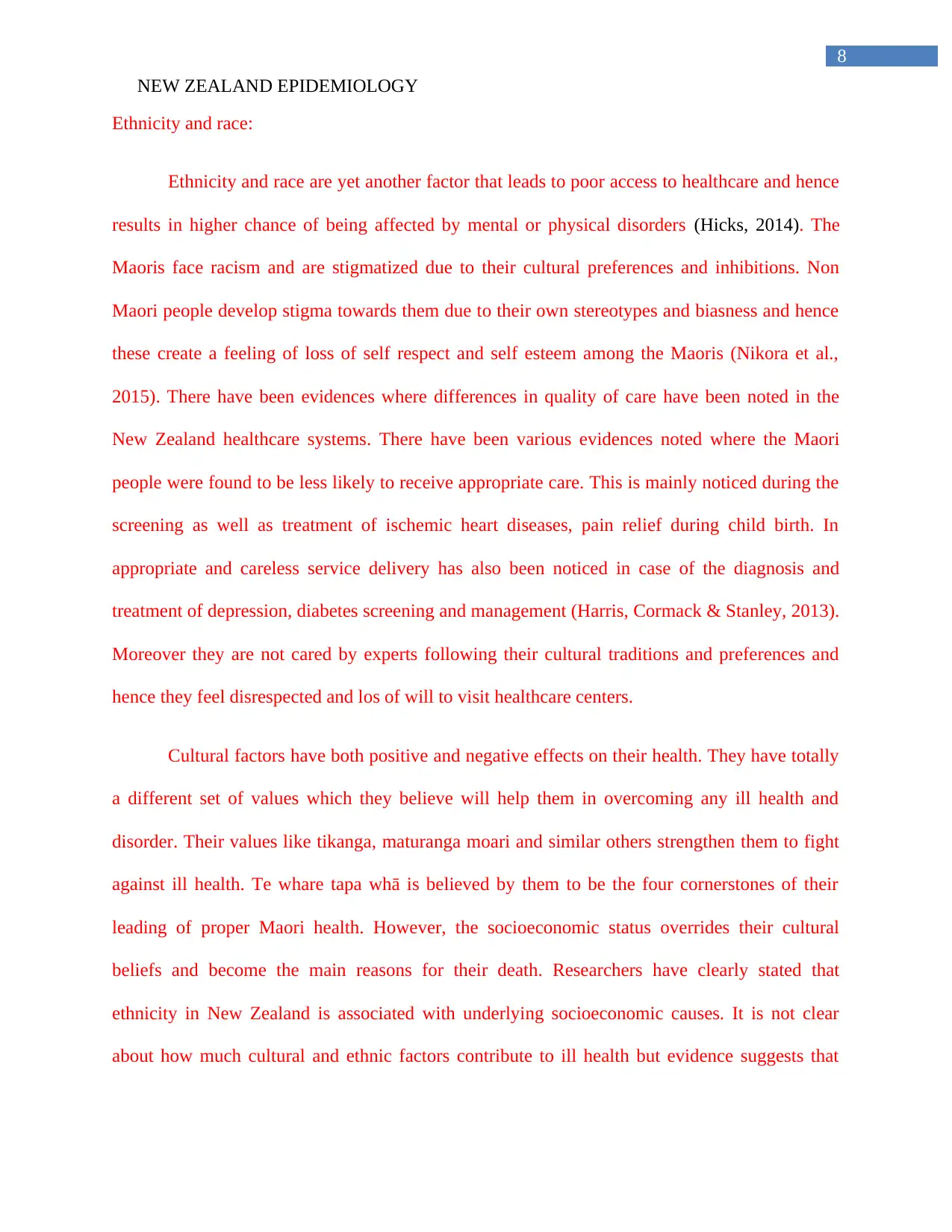
8
NEW ZEALAND EPIDEMIOLOGY
Ethnicity and race:
Ethnicity and race are yet another factor that leads to poor access to healthcare and hence
results in higher chance of being affected by mental or physical disorders (Hicks, 2014). The
Maoris face racism and are stigmatized due to their cultural preferences and inhibitions. Non
Maori people develop stigma towards them due to their own stereotypes and biasness and hence
these create a feeling of loss of self respect and self esteem among the Maoris (Nikora et al.,
2015). There have been evidences where differences in quality of care have been noted in the
New Zealand healthcare systems. There have been various evidences noted where the Maori
people were found to be less likely to receive appropriate care. This is mainly noticed during the
screening as well as treatment of ischemic heart diseases, pain relief during child birth. In
appropriate and careless service delivery has also been noticed in case of the diagnosis and
treatment of depression, diabetes screening and management (Harris, Cormack & Stanley, 2013).
Moreover they are not cared by experts following their cultural traditions and preferences and
hence they feel disrespected and los of will to visit healthcare centers.
Cultural factors have both positive and negative effects on their health. They have totally
a different set of values which they believe will help them in overcoming any ill health and
disorder. Their values like tikanga, maturanga moari and similar others strengthen them to fight
against ill health. Te whare tapa whā is believed by them to be the four cornerstones of their
leading of proper Maori health. However, the socioeconomic status overrides their cultural
beliefs and become the main reasons for their death. Researchers have clearly stated that
ethnicity in New Zealand is associated with underlying socioeconomic causes. It is not clear
about how much cultural and ethnic factors contribute to ill health but evidence suggests that
NEW ZEALAND EPIDEMIOLOGY
Ethnicity and race:
Ethnicity and race are yet another factor that leads to poor access to healthcare and hence
results in higher chance of being affected by mental or physical disorders (Hicks, 2014). The
Maoris face racism and are stigmatized due to their cultural preferences and inhibitions. Non
Maori people develop stigma towards them due to their own stereotypes and biasness and hence
these create a feeling of loss of self respect and self esteem among the Maoris (Nikora et al.,
2015). There have been evidences where differences in quality of care have been noted in the
New Zealand healthcare systems. There have been various evidences noted where the Maori
people were found to be less likely to receive appropriate care. This is mainly noticed during the
screening as well as treatment of ischemic heart diseases, pain relief during child birth. In
appropriate and careless service delivery has also been noticed in case of the diagnosis and
treatment of depression, diabetes screening and management (Harris, Cormack & Stanley, 2013).
Moreover they are not cared by experts following their cultural traditions and preferences and
hence they feel disrespected and los of will to visit healthcare centers.
Cultural factors have both positive and negative effects on their health. They have totally
a different set of values which they believe will help them in overcoming any ill health and
disorder. Their values like tikanga, maturanga moari and similar others strengthen them to fight
against ill health. Te whare tapa whā is believed by them to be the four cornerstones of their
leading of proper Maori health. However, the socioeconomic status overrides their cultural
beliefs and become the main reasons for their death. Researchers have clearly stated that
ethnicity in New Zealand is associated with underlying socioeconomic causes. It is not clear
about how much cultural and ethnic factors contribute to ill health but evidence suggests that
⊘ This is a preview!⊘
Do you want full access?
Subscribe today to unlock all pages.

Trusted by 1+ million students worldwide
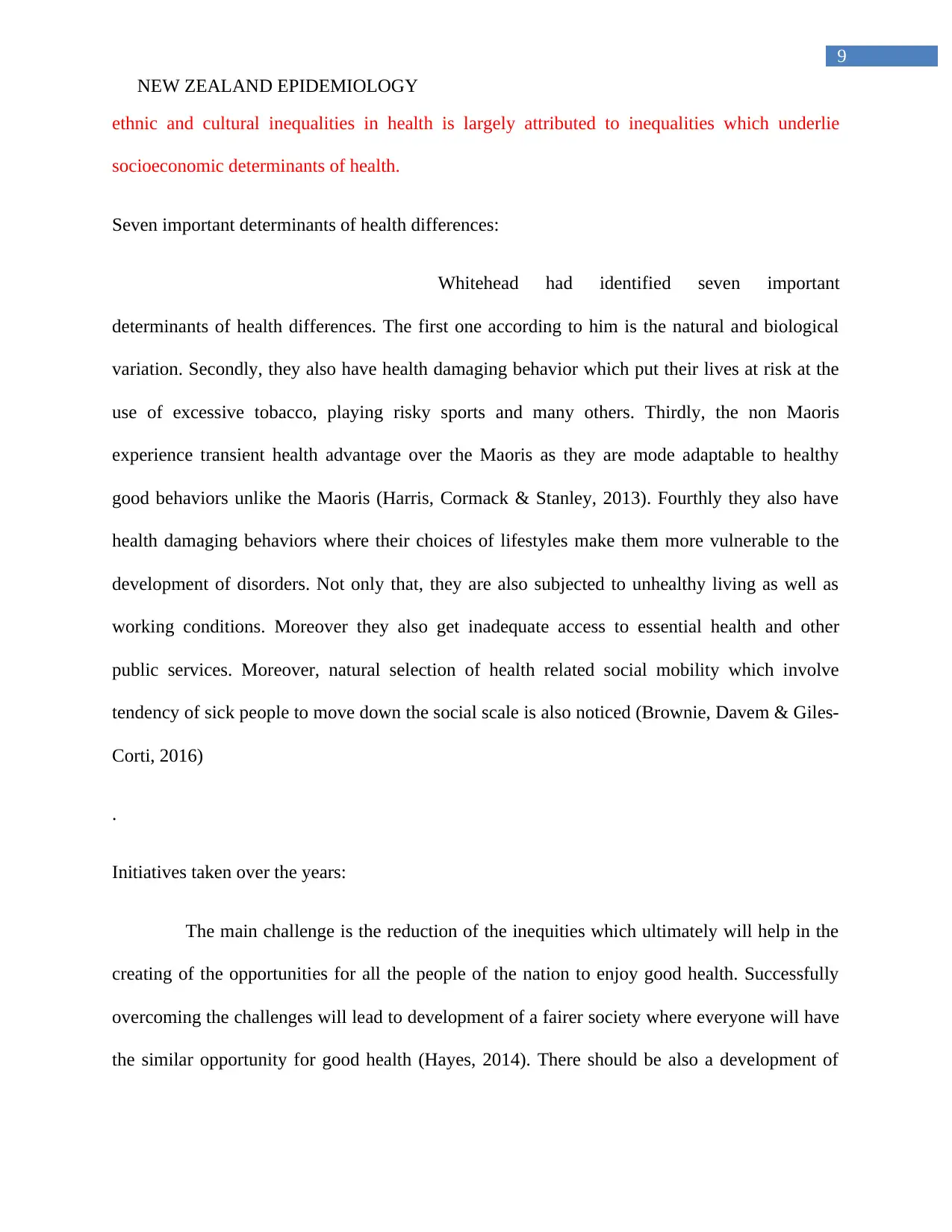
9
NEW ZEALAND EPIDEMIOLOGY
ethnic and cultural inequalities in health is largely attributed to inequalities which underlie
socioeconomic determinants of health.
Seven important determinants of health differences:
Whitehead had identified seven important
determinants of health differences. The first one according to him is the natural and biological
variation. Secondly, they also have health damaging behavior which put their lives at risk at the
use of excessive tobacco, playing risky sports and many others. Thirdly, the non Maoris
experience transient health advantage over the Maoris as they are mode adaptable to healthy
good behaviors unlike the Maoris (Harris, Cormack & Stanley, 2013). Fourthly they also have
health damaging behaviors where their choices of lifestyles make them more vulnerable to the
development of disorders. Not only that, they are also subjected to unhealthy living as well as
working conditions. Moreover they also get inadequate access to essential health and other
public services. Moreover, natural selection of health related social mobility which involve
tendency of sick people to move down the social scale is also noticed (Brownie, Davem & Giles-
Corti, 2016)
.
Initiatives taken over the years:
The main challenge is the reduction of the inequities which ultimately will help in the
creating of the opportunities for all the people of the nation to enjoy good health. Successfully
overcoming the challenges will lead to development of a fairer society where everyone will have
the similar opportunity for good health (Hayes, 2014). There should be also a development of
NEW ZEALAND EPIDEMIOLOGY
ethnic and cultural inequalities in health is largely attributed to inequalities which underlie
socioeconomic determinants of health.
Seven important determinants of health differences:
Whitehead had identified seven important
determinants of health differences. The first one according to him is the natural and biological
variation. Secondly, they also have health damaging behavior which put their lives at risk at the
use of excessive tobacco, playing risky sports and many others. Thirdly, the non Maoris
experience transient health advantage over the Maoris as they are mode adaptable to healthy
good behaviors unlike the Maoris (Harris, Cormack & Stanley, 2013). Fourthly they also have
health damaging behaviors where their choices of lifestyles make them more vulnerable to the
development of disorders. Not only that, they are also subjected to unhealthy living as well as
working conditions. Moreover they also get inadequate access to essential health and other
public services. Moreover, natural selection of health related social mobility which involve
tendency of sick people to move down the social scale is also noticed (Brownie, Davem & Giles-
Corti, 2016)
.
Initiatives taken over the years:
The main challenge is the reduction of the inequities which ultimately will help in the
creating of the opportunities for all the people of the nation to enjoy good health. Successfully
overcoming the challenges will lead to development of a fairer society where everyone will have
the similar opportunity for good health (Hayes, 2014). There should be also a development of
Paraphrase This Document
Need a fresh take? Get an instant paraphrase of this document with our AI Paraphraser
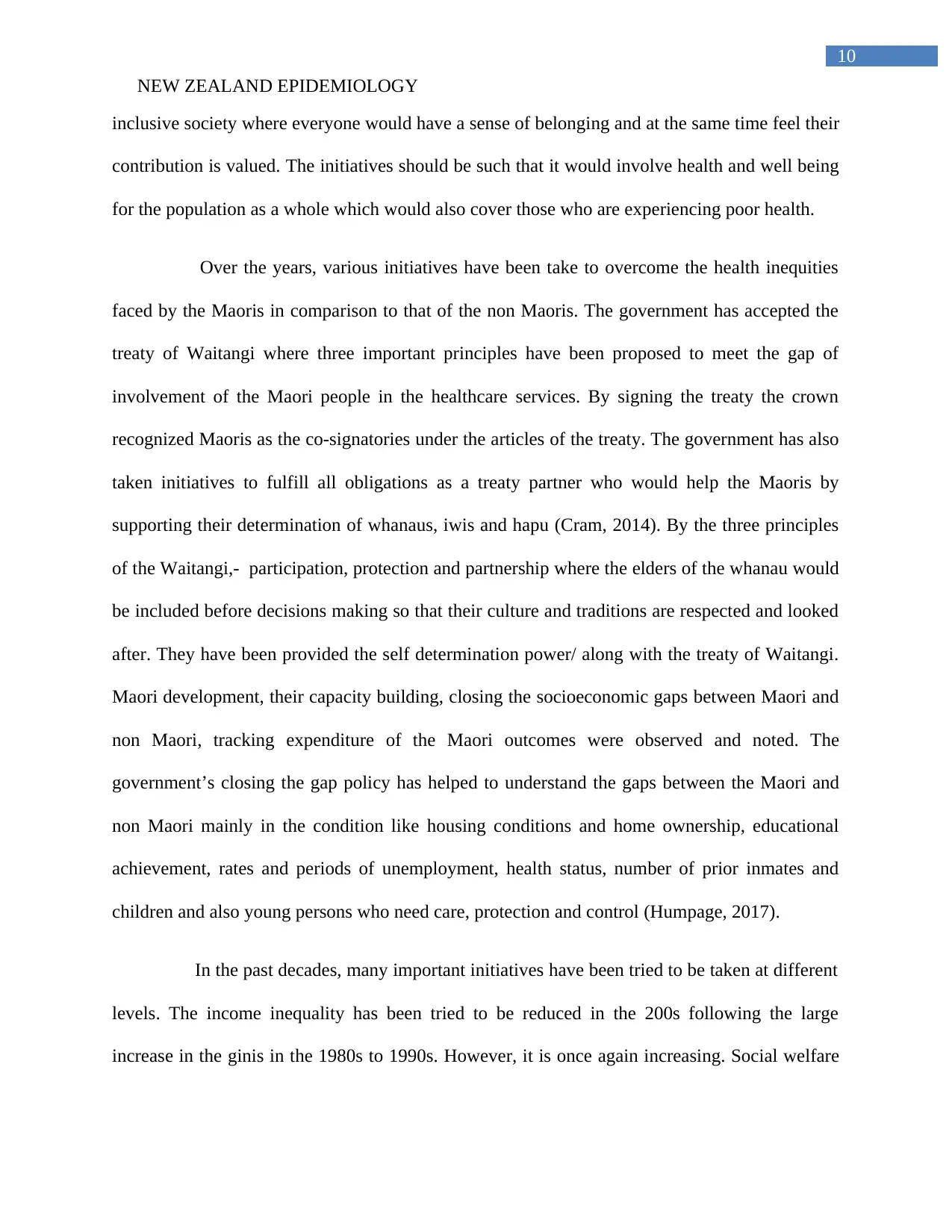
10
NEW ZEALAND EPIDEMIOLOGY
inclusive society where everyone would have a sense of belonging and at the same time feel their
contribution is valued. The initiatives should be such that it would involve health and well being
for the population as a whole which would also cover those who are experiencing poor health.
Over the years, various initiatives have been take to overcome the health inequities
faced by the Maoris in comparison to that of the non Maoris. The government has accepted the
treaty of Waitangi where three important principles have been proposed to meet the gap of
involvement of the Maori people in the healthcare services. By signing the treaty the crown
recognized Maoris as the co-signatories under the articles of the treaty. The government has also
taken initiatives to fulfill all obligations as a treaty partner who would help the Maoris by
supporting their determination of whanaus, iwis and hapu (Cram, 2014). By the three principles
of the Waitangi,- participation, protection and partnership where the elders of the whanau would
be included before decisions making so that their culture and traditions are respected and looked
after. They have been provided the self determination power/ along with the treaty of Waitangi.
Maori development, their capacity building, closing the socioeconomic gaps between Maori and
non Maori, tracking expenditure of the Maori outcomes were observed and noted. The
government’s closing the gap policy has helped to understand the gaps between the Maori and
non Maori mainly in the condition like housing conditions and home ownership, educational
achievement, rates and periods of unemployment, health status, number of prior inmates and
children and also young persons who need care, protection and control (Humpage, 2017).
In the past decades, many important initiatives have been tried to be taken at different
levels. The income inequality has been tried to be reduced in the 200s following the large
increase in the ginis in the 1980s to 1990s. However, it is once again increasing. Social welfare
NEW ZEALAND EPIDEMIOLOGY
inclusive society where everyone would have a sense of belonging and at the same time feel their
contribution is valued. The initiatives should be such that it would involve health and well being
for the population as a whole which would also cover those who are experiencing poor health.
Over the years, various initiatives have been take to overcome the health inequities
faced by the Maoris in comparison to that of the non Maoris. The government has accepted the
treaty of Waitangi where three important principles have been proposed to meet the gap of
involvement of the Maori people in the healthcare services. By signing the treaty the crown
recognized Maoris as the co-signatories under the articles of the treaty. The government has also
taken initiatives to fulfill all obligations as a treaty partner who would help the Maoris by
supporting their determination of whanaus, iwis and hapu (Cram, 2014). By the three principles
of the Waitangi,- participation, protection and partnership where the elders of the whanau would
be included before decisions making so that their culture and traditions are respected and looked
after. They have been provided the self determination power/ along with the treaty of Waitangi.
Maori development, their capacity building, closing the socioeconomic gaps between Maori and
non Maori, tracking expenditure of the Maori outcomes were observed and noted. The
government’s closing the gap policy has helped to understand the gaps between the Maori and
non Maori mainly in the condition like housing conditions and home ownership, educational
achievement, rates and periods of unemployment, health status, number of prior inmates and
children and also young persons who need care, protection and control (Humpage, 2017).
In the past decades, many important initiatives have been tried to be taken at different
levels. The income inequality has been tried to be reduced in the 200s following the large
increase in the ginis in the 1980s to 1990s. However, it is once again increasing. Social welfare
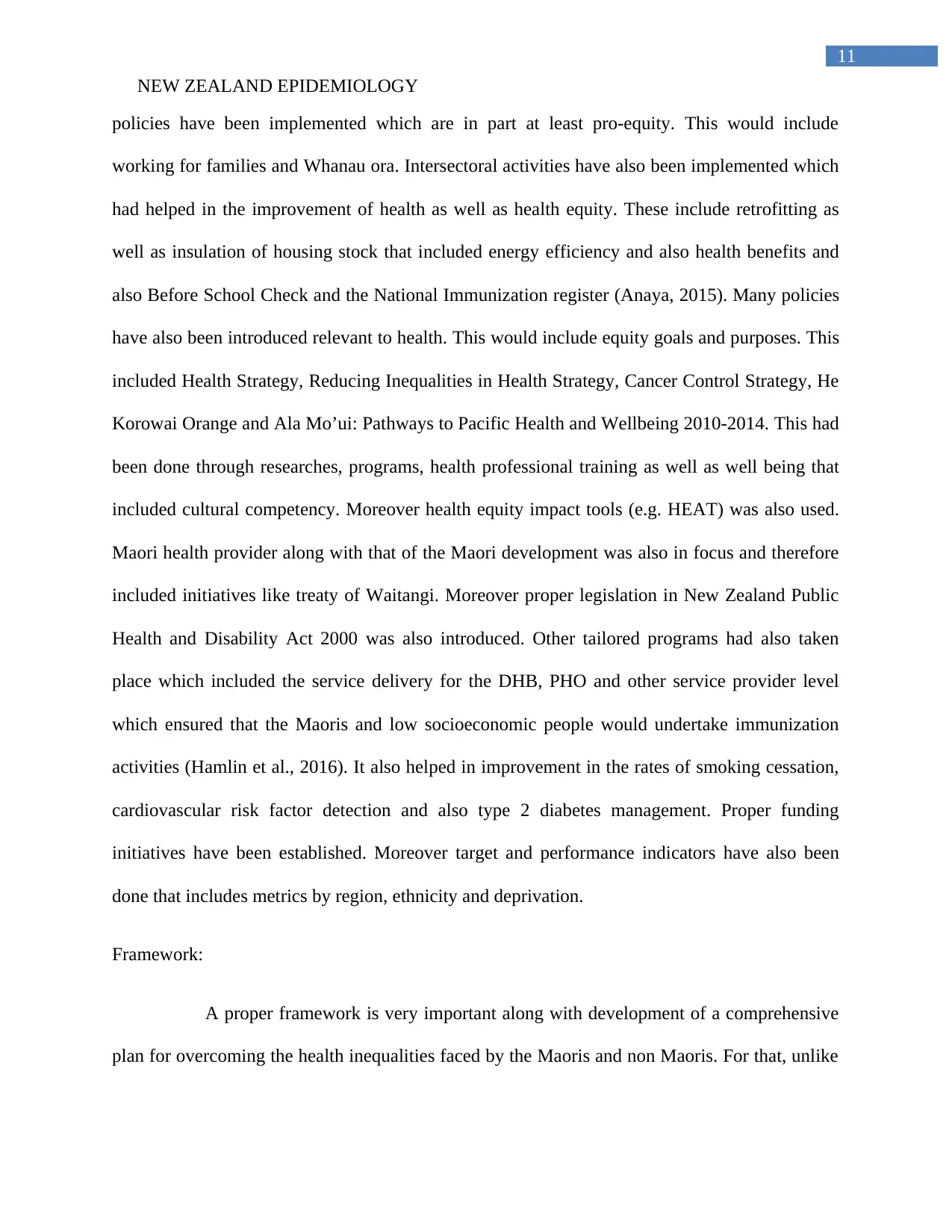
11
NEW ZEALAND EPIDEMIOLOGY
policies have been implemented which are in part at least pro-equity. This would include
working for families and Whanau ora. Intersectoral activities have also been implemented which
had helped in the improvement of health as well as health equity. These include retrofitting as
well as insulation of housing stock that included energy efficiency and also health benefits and
also Before School Check and the National Immunization register (Anaya, 2015). Many policies
have also been introduced relevant to health. This would include equity goals and purposes. This
included Health Strategy, Reducing Inequalities in Health Strategy, Cancer Control Strategy, He
Korowai Orange and Ala Mo’ui: Pathways to Pacific Health and Wellbeing 2010-2014. This had
been done through researches, programs, health professional training as well as well being that
included cultural competency. Moreover health equity impact tools (e.g. HEAT) was also used.
Maori health provider along with that of the Maori development was also in focus and therefore
included initiatives like treaty of Waitangi. Moreover proper legislation in New Zealand Public
Health and Disability Act 2000 was also introduced. Other tailored programs had also taken
place which included the service delivery for the DHB, PHO and other service provider level
which ensured that the Maoris and low socioeconomic people would undertake immunization
activities (Hamlin et al., 2016). It also helped in improvement in the rates of smoking cessation,
cardiovascular risk factor detection and also type 2 diabetes management. Proper funding
initiatives have been established. Moreover target and performance indicators have also been
done that includes metrics by region, ethnicity and deprivation.
Framework:
A proper framework is very important along with development of a comprehensive
plan for overcoming the health inequalities faced by the Maoris and non Maoris. For that, unlike
NEW ZEALAND EPIDEMIOLOGY
policies have been implemented which are in part at least pro-equity. This would include
working for families and Whanau ora. Intersectoral activities have also been implemented which
had helped in the improvement of health as well as health equity. These include retrofitting as
well as insulation of housing stock that included energy efficiency and also health benefits and
also Before School Check and the National Immunization register (Anaya, 2015). Many policies
have also been introduced relevant to health. This would include equity goals and purposes. This
included Health Strategy, Reducing Inequalities in Health Strategy, Cancer Control Strategy, He
Korowai Orange and Ala Mo’ui: Pathways to Pacific Health and Wellbeing 2010-2014. This had
been done through researches, programs, health professional training as well as well being that
included cultural competency. Moreover health equity impact tools (e.g. HEAT) was also used.
Maori health provider along with that of the Maori development was also in focus and therefore
included initiatives like treaty of Waitangi. Moreover proper legislation in New Zealand Public
Health and Disability Act 2000 was also introduced. Other tailored programs had also taken
place which included the service delivery for the DHB, PHO and other service provider level
which ensured that the Maoris and low socioeconomic people would undertake immunization
activities (Hamlin et al., 2016). It also helped in improvement in the rates of smoking cessation,
cardiovascular risk factor detection and also type 2 diabetes management. Proper funding
initiatives have been established. Moreover target and performance indicators have also been
done that includes metrics by region, ethnicity and deprivation.
Framework:
A proper framework is very important along with development of a comprehensive
plan for overcoming the health inequalities faced by the Maoris and non Maoris. For that, unlike
⊘ This is a preview!⊘
Do you want full access?
Subscribe today to unlock all pages.

Trusted by 1+ million students worldwide
1 out of 20
Related Documents
Your All-in-One AI-Powered Toolkit for Academic Success.
+13062052269
info@desklib.com
Available 24*7 on WhatsApp / Email
![[object Object]](/_next/static/media/star-bottom.7253800d.svg)
Unlock your academic potential
Copyright © 2020–2025 A2Z Services. All Rights Reserved. Developed and managed by ZUCOL.





